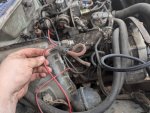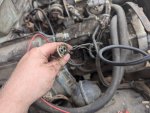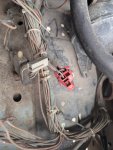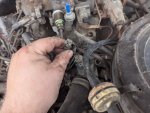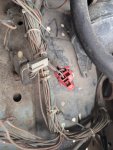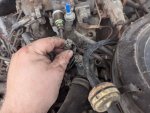Hopefully I can help with a little of this. I have no idea about your vacuum lines. I don't have an EVTM for the 1984, but the one I have for 85 is woefully inadequate for the vacuum system.
The first two pictures. I see something in the 85 Ranger EVTM on the right inner fender called a "temperature compensation pump" in one figure and a "temperature compensated accelerator pump" in the 2.8L engine control wire diagram. The picture of the item int he figure looks like the connector could be a match. The diagram shows the connector having a red (R) wire, and an orange/white (O/W) wire.
If you look at the vacuum diagrams that Jim posted in the tech library, you'll find this image. Link for reference:
Ford Ranger Engine Vacuum Hose Diagrams
Some of the abbreviations for reference:
TCP = Temperature Compensated Accelerator Pump
VRESER = Vacuum Reservoir
SOL V = Solenoid Valve
So this Pump, or solenoid valve also has a vacuum component. The vacuum is also connected into the Thermicator system (DUMP & DIVERT solenoids) and EGR system. All of these solenoid valves are located on that fender. Wouldn't surprise me if things started failing/breaking and they tried bypassing/deleting them.
^^ I'm almost certain that both connectors in this picture are related to onboard self test. The red connector is definitely for self tests, it's labeled as C1984 in the 85 EVTM.
I seem to recall that the gray was used for self tests too, and it looks like C1985 in the EVTM, but I can't find it in the 2.8L engine diagram. All of that diagonstics stuff was long gone from my 84, so I'm recalling info from threads about general diagnostics on the older Rangers.
There is also a C134 near the same location that does show up in the 2.8L engine diagram. The C134 connector looks similar in drawings and is tied into the AC system.
The 85 manual shows C1985 as having a white/red dotted (W/R D) wire, and C134 as having a black/yellow dotted (B/Y) wire.
LAST MINUTE EDIT: On closer inspection, there are two of those single wire connectors in the picture. Maybe both are there. In the figures, C1985 is closer to the red C1984 connector.
^^ Not sure. Again all of this stuff was gone from my 84 2.8L and it was converted to Holley carburetor back in the 80s. In the 85 EVTM I'm showing a single wire connector that would have gone to a "Carburetor Float Bowl Vent Solenoid". If I'm reading the picture right it would have been in that general area. It shows the connector labeled C14 as being black in color and having a red/yellow hashed (R/Y H) wire.

